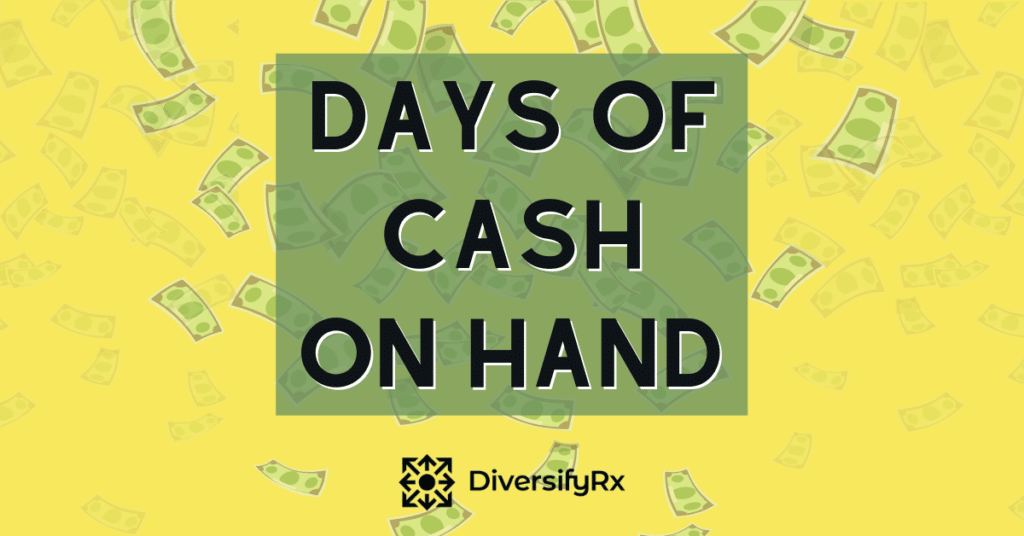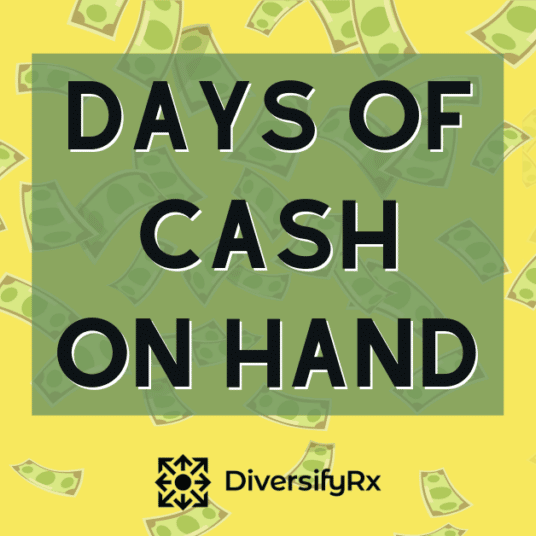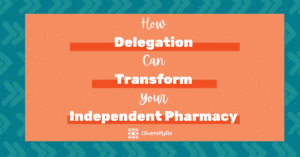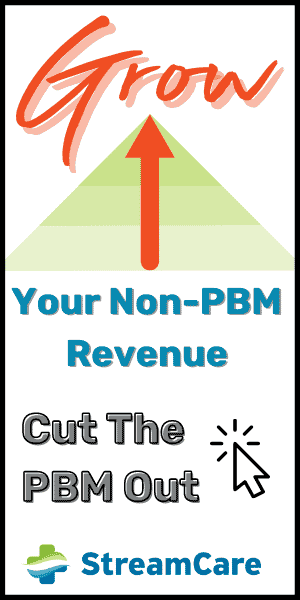Reduce the everyday stress of checking your bank account and increase your pharmacy’s days of cash on hand!
Talking about cash on hand isn’t very sexy, and many pharmacy owners prefer to skip over this critical topic. It is much more exciting to talk about supplements, PGx testing, or getting more efficiency from your employees. While it might feel a little complicated, it isn’t, once you break it down and understand what it is and how to get more of it. It’s one of the most valuable points of information you can learn for your pharmacy’s health.
What Does Having Cash On Hand Mean?
It’s essential to understand your pharmacy’s overall financial health.
The days of cash on hand number is a key performance indicator (KPI) of how many days you can operate your pharmacy based on the amount of cash you have in the bank right now. The more days of cash readily available money you have in the bank, the stronger your cash flow is.
Having enough cash on hand means you are solvent and stable. You aren’t having to check your bank account each morning or worry if a payment will go through. With more cash available, you can make critically important decisions such as dropping your PSAO, switching wholesalers or hiring an employee without worrying about short-term negative cash flow impacts. This flexibility brings a whole new freedom to pharmacy ownership.
Calculate Your Days of Cash On Hand
You may have heard of different ways to calculate the number of days of cash on hand, such as excluding your COGS from the calculation. I can’t entirely agree with this way of calculating because it usually comes from someone without intimate pharmacy experience. In the pharmacy world, inventory costs are a significant drain on our cash. I include all expenses and inventory purchases in this calculation for a more accurate representation of the health of the pharmacy.
How To Calculate Cash On Hand
- Add up available cash from all your accounts; this is your total cash.
- Total up your expenses from the previous month and then divide it by the number of days in the month. This answer is your average daily expense rate.
- Total Cash ÷ Average Daily Expenses = Days of Cash On Hand
Now you have your days of cash on hand.
So, what did you get? Your goal should be 15 days or more, as that indicates a strong pharmacy. If you find yourself with less than 15 days of cash on hand, then continue reading for some suggestions on how to increase your pharmacy’s cash.
7 Ideas On How You Can Increase Your Cash On Hand
If you’re not feeling good about the amount of cash on hand, find ways to make more. Ideally, the most effective methods will be cash-based services where you receive payment immediately. This way, your profit turns into cash in the bank right away. Other options are for high-profit products and services as they tend to add to your bank account as well. There are many ways you can increase your cash on hand in the pharmacy. Here are 7 ideas on how to do just that.
Non-PBM and Cash-Based Revenues
Battling with PBMs can cause cash flow issues. You can’t eliminate PBMs unless you’re going cash-only, but you can reduce your reliance on them by focusing on growing your non-PBM revenue and your cash-based income.
1. Grow your clinical services
2. Get paid for your knowledge
3. Sell hot OTC items for cash
4. Eliminate PBMs from some prescriptions
Most pharmacies have 90% or more of their revenue flow through a PBM, creating audits, clawbacks, and poor cash flow problems.
A few of my favorite resources for non-PBM and cash revenue are:
- StreamCare – direct billing work comp scripts, dramatically increase margin by eliminating the PBMs.
- RxGenomix – get paid $90 for each interpretation of PGx results with a turn-key solution. Use code rxg115 to save.
- Weight Loss Coaching – weight loss and healthy living coaching.
- Physician 360 – point of care testing with included telemedicine services.
- Biophotonic Scanner – reveals your patients’ antioxidant score in less than a minute and helps to easily sell supplements.
OTC Pharmacy Sales: OTC $ Per Hour
An easy way to diversify your revenue is to increase the number of OTCs you’re selling. OTCs are typically very profitable, it’s a cash sale, and best of all, you don’t need a third party. Some successful pharmacies can sell up to 6-figures of OTCs each month, creating a nice positive cash flow.
You won’t know how well you’re selling OTCs unless you track, measure, and report on how well your staff is selling these items, and the easiest way to do this is with a POS system where each employee has to log in to use it. The POS helps track sales per employee with just a simple push of a button, or you can do it manually.
To keep the momentum going, consider rewarding your employees for improving OTC sales. Rewards can be cash bonuses, time off, or my favorite–schedule picking priority!
Synchronization
Many pharmacies aren’t taking full advantage of a robust synchronization program. A well-run synchronization is all about streamlining operations, decreasing your inventory needs, and improving your cash flow. Pharmacy owners often miss the vast profits from back-end opportunities of a sync program. You can dramatically increase revenue and profit just by taking advantage of the ‘sync moment’ to offer other relevant services. These other services could be PGx, OTCs, CBD, MTM, diabetic shoes, or anything else that helps patients based on their medications and earns you additional incomes.
New Patients
If you’ve followed me for a while, you’ll know I always say, “If you are not growing, you are shrinking.” You already know that patients are the source of your revenue, so if you’re not already tracking them at a granular level, start today. Tracking your patients is a good lead measure for things to come.
The number of your new patients can help predict cash flow and if revenue and profits will go up or down, and adding new patients can indicate if your business is healthy, if marketing efforts are working, and if you’ve got a good staff. Because of this, I track new patients weekly, which can be rolled up to monthly numbers for financial purposes. To increase your cash with new patients, focus on selling them profitable OTC items first.
Expenses
Darned expenses. Do you find that your cash is paying for unnecessary services and products that aren’t really needed or aren’t performing quite as expected?
It’s a best practice to meet with your accountant or bookkeeper twice a year to go over a detailed expense report. You never know when little expenses like $50 monthly recurring fees get overlooked, as well as bundled costs. When was the last time you examined your PSAO fees?
Another area is your operational and consumable expenses like labels, vials, and toner. When was the last time your price shopped for these products? I have helped many pharmacies save thousands on ink and toner just by buying through PSA.
AR Percentage Received
Pharmacy cash flow problems can happen because revenue is put into accounts receivable (AR), which means you have to wait (days, weeks, or months) to get your money. Do you know how much of this money you are supposed to receive that you actually get?
Tracking is key! There’s no doubt you should be tracking your AR received ratio. If you’re planning to receive $100,000, do you get that all of that amount, or did you only get $98,000? How do you know the check didn’t get lost in the mail? Tracking can be just about impossible to do manually – your PSAO should be offering this service, or using one of the many third-party AR companies is probably the best bet to help with this.
Payroll
Did you know that your second-largest expenditure of cash is your payroll? That means you need to do a fantastic job managing this expense if you want extra days of cash on hand.
It’s a no-brainer to know that you’ll need to reduce this expense for your cash flow to loosen up. Lowering payroll doesn’t mean cutting your employee headcount, although taking a look at it is a good idea. Once you know your payroll ratio percentage, you can determine what decisions you need to make to better access your cash.
Reducing hours across the board is one quick way to get it under control without letting anyone go. Reducing 1 hour each from 1 or 2 employees could make a measurable difference in your savings! You can also ask if anyone wants additional unpaid time off because you never know when someone might jump at the opportunity.
Check out this article to find more ways to improve your pharmacy cash flow! If you would like any additional information or ideas on improving any of these areas, join our private DiversifyRx Facebook Group

















